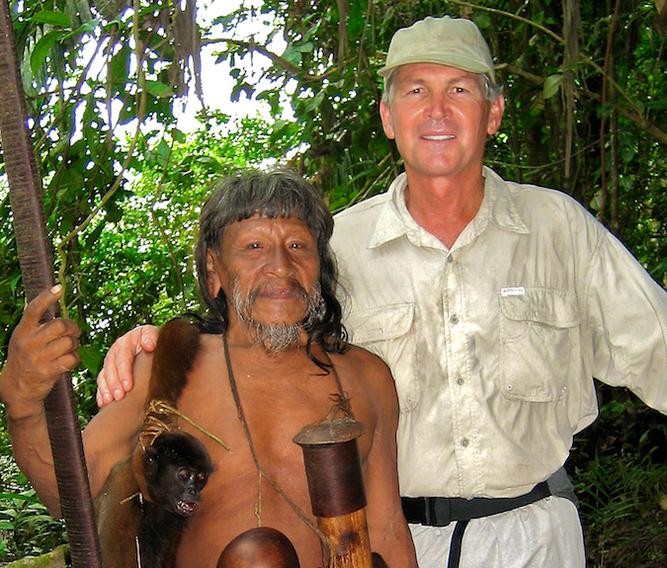They venerate the jaguar, and believe they are children of Nweke (thunder). They call themselves the bravest people in the rainforest. Only five or six decades ago, Huaorani used stone axes and lived as nomadic hunters and gatherers. Now life is changing fast.
A few tribal Huaorani still continue as they have for a millennia, existing in supreme harmony with nature, hunting with blowguns and spears. I have visited one extremely remote village for the past thirteen years and have created a documentary photobook about these beautiful people and their remarkable life in the rainforest before it is lost forever. I write about their life and my experience with them. It’s about one of the last remaining tribal people living unchanged in a changing world.
The world outside the forest has a great opportunity to gain priceless information from these wise and knowledgeable people before it disappears. Now many of the young wear western clothes and long for radios and whisky. For the traditional Huaorani, between this world and the next stretches the Great “Obe” (anaconda). To reach the “the next place”, one must jump over the Great Obe into paradise, a forest of peace and good hunting. If you live your life correctly you can jump over and meet all the worthy Huaorani in the next life. Huaorani elders are trying to keep their traditions alive, but many are interested in what the western world can offer. I overheard a conversation a chief had with his grandson, who had just come back from working in an oil camp wearing sunglasses, shorts and a t-shirt. "I will jump over the Great “Obe” into paradise,” the chief said “but you will never. You will come back as a termite!...'
(Excerpt from book) 'I crash through the Amazonian underbrush as a tangled vine grabs my foot, and I plunge tumbling into a fetid, green, swampy pool. A naked four and a half foot native runs by, nearly crowning me as I duck below his ten-foot blowgun. Spitting mud, I get up and dash headlong after him. The woolly monkey we are chasing races one hundred and fifty feet above us through the dark canopy, allowing only brief glimpses as he leaps from tree to tree. When I catch up with the hunter, he is drawing a nineteen-inch poison-tipped dart from the quiver hanging around his neck. He cuts a notch near its point with a row of razor sharp piranha teeth, and then spins a short length of fluffy white fiber circling the dart’s base as he fits it into his blowgun. All the while his eyes fix intently on one point high in the treetops. I scan the foliage, but I am unable to spot any glimpse of his prey. The hunter positions the blowgun on his lips, and I follow the aim of the blowpipe. Lining up countless tiny openings through the myriad layers of vegetation, I notice a tiny, barely perceptible, dark patch of movement in the loftiest branches. Surely, I think, a shot now would be futile. Firing through that array of minute gaps would be like directing an arrow up ten stories, through a multitude of three-inch openings in each floor. He fills his lungs, and throwing his body forward, gives the blowgun a great blast of air and makes a hit...'
I have returned to visit the Huaorani, a tribal group deep in Ecuador’s remote Amazon Basin. They live within an isolated and protected region between the Curaray and Napo Rivers, designated the Intangible Zone. Huaorani land is prohibited to all outsiders unless given permission to visit, however it is rich with oil and hardwoods. Lumber concerns, oil camps and small settlements surround Huaorani territory and the lure of a quick buck brings these outsiders into Huaorani land from time to time. The result is that every few months a death by spearpoint is reported.
HUAORANI
An Amazon Tribe in the 21st Century
BRUCE BARRON
$125. Includes shipping
Credit card above or by check to:
Bruce Barron
P.O. Box 100, Sunset Beach, CA 90742 USA
"As my ancestors lived, so also will I live! As my ancestors died, so also will I die! Weapon, Weapon, Huaorani Weapon!" Chief Kemper
Bruce Barron has been a professional expedition guide, explorer and photographer for 30 years. He established Barron Adventures, an adventure expedition company in 1985. Bruce began guiding backpacking and climbing trips at the age of 15, and today guides expeditions throughout the world. He has led numerous expeditions to remote corners of the planet, including successful ascents of major world peaks and has led several first explorations in the Andes, Himalayas and Amazon Basin. His adventure photography has been published in periodicals such as Esquire, Reader’s Digest and Shape Magazine.
In 1996 Bruce led the Barron/Pickard Heath River Exploration, the first expedition to discover the source of the Heath River, which delineates the Peruvian/Bolivian Amazon.
The book is filled with nearly 100 beautiful photos depicting the Huaorani and the rainforest they live and hunt in, as well as stories and descriptions of their way of life. It describes these remarkable people living in harmony with nature today, as their ancestors have for thousands of years.


